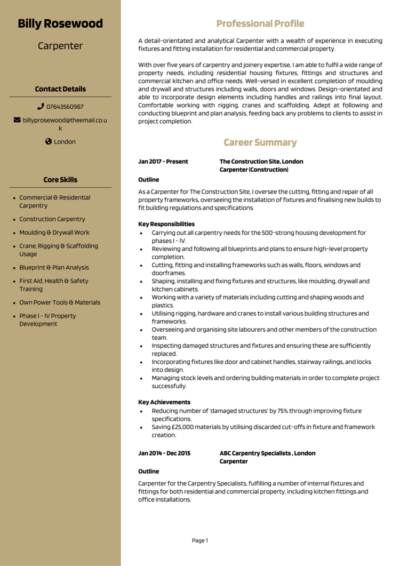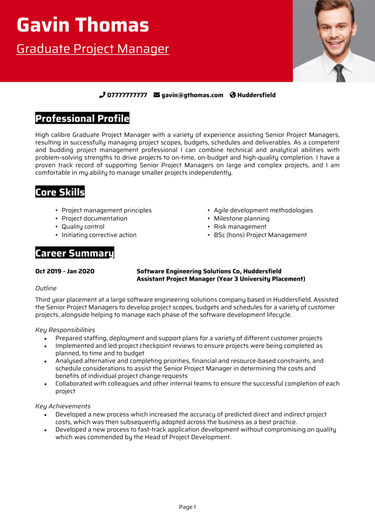Precision, durability, and expert craftsmanship – these aren’t just the qualities of your carpentry: they’re what makes a strong CV stand out to employers.
But securing a new carpentry role requires more than just technical ability – you need a well-structured CV that showcases your expertise, experience, and ability to deliver high-quality work. This guide and its Carpenter CV examples will enable you to do exactly that.
Carpenter CV example
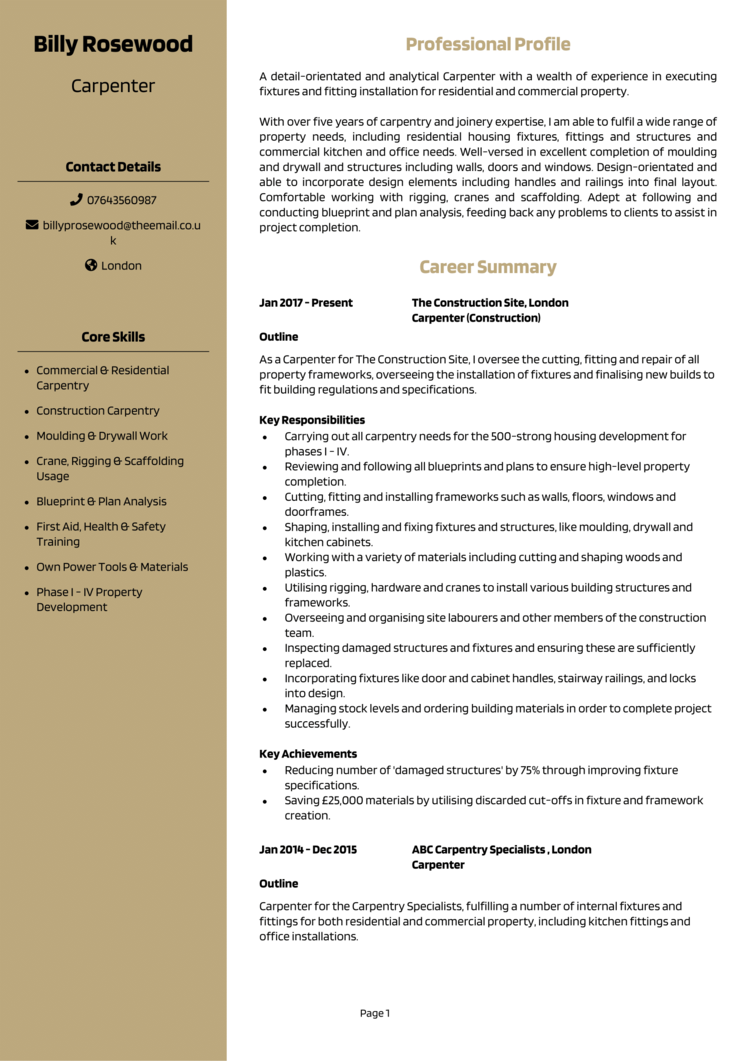
Apprentice Carpenter CV example
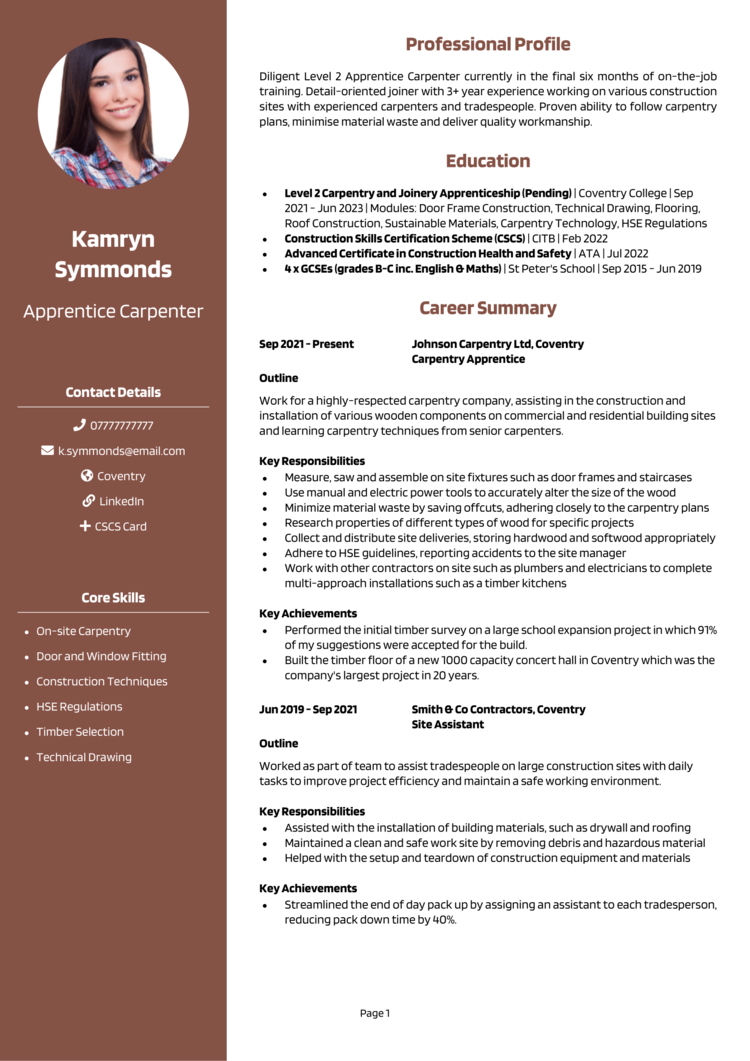
Self-Employed Carpenter CV
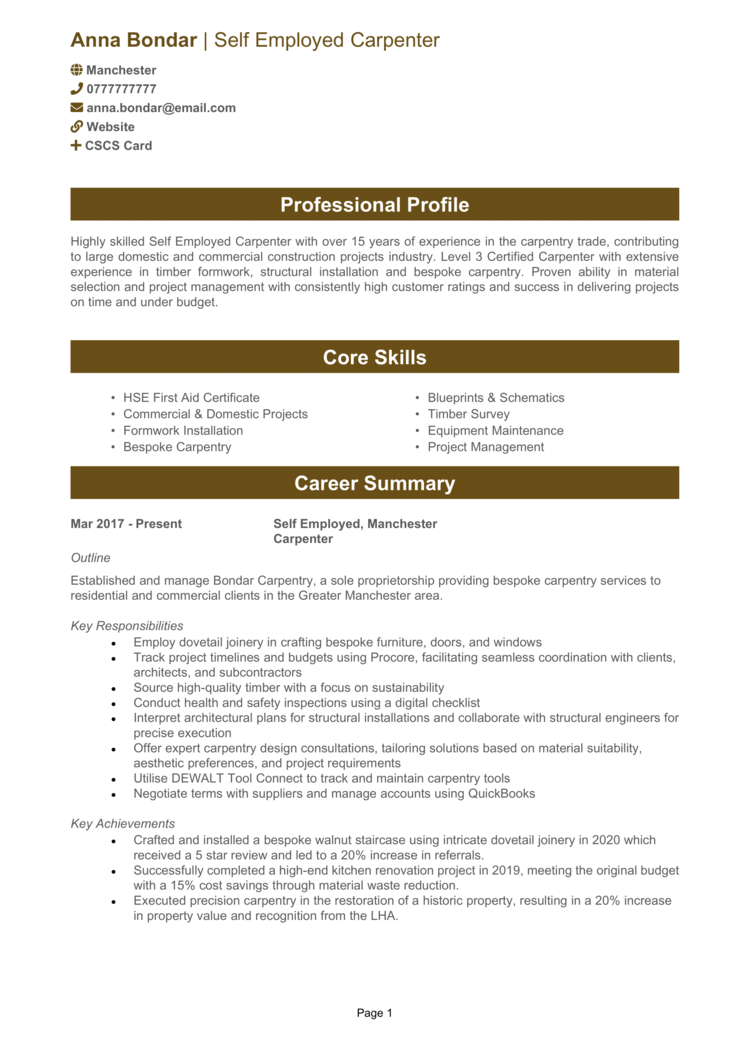
Shuttering Carpenter CV example
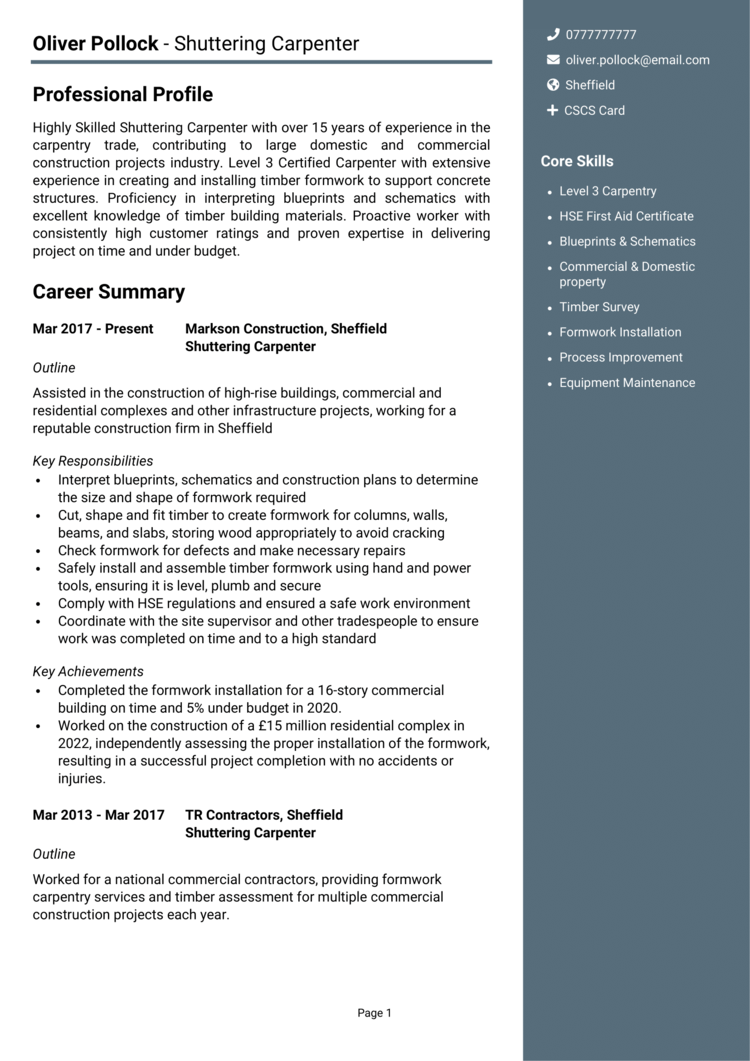
How to write your Carpenter CV
Learn how to create your own interview-winning Carpenter CV with this simple step-by-step guide.
Writing a CV that conveys your practical skills is difficult: you’ll need to balance your practical knowledge with your past experience. This guide will help you create a CV that highlights your experience, skills, and qualifications in a way that’s just as professional as your work.
Structuring your Carpenter CV

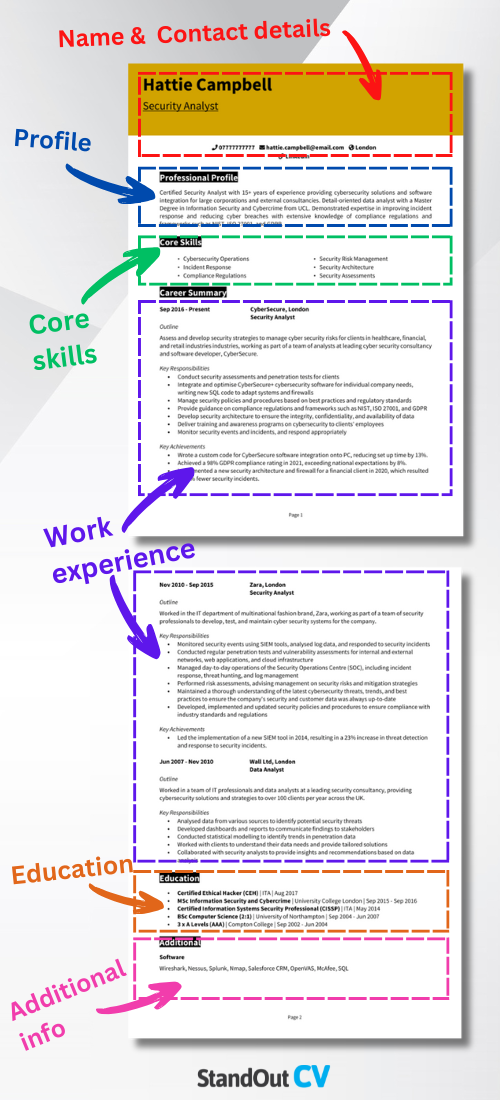
A carpenter’s CV structure should be as solid and well-assembled as the work they produce. With the right layout, you’ll ensure that hiring managers immediately see your expertise and experience. Avoid the mistake of an incoherent format that leaves recruiters searching for what it actually is that makes you the right fit.
Here’s the structure your CV should follow:
- Name and contact details – Ensure your name and personal details are easily visible at the top. A photo is optional and depends on the role.
- Profile – Craft a concise summary of your carpentry experience, technical skills, and project expertise.
- Core skills – Provide a quick overview of essential carpentry abilities, such as framework construction, joinery, and blueprint reading.
- Work experience – Outline your previous roles, focusing on project contributions and technical responsibilities.
- Education – Outline any carpentry apprenticeships, trade qualifications, or degrees.
- Additional info – You can add hobbies or carpentry awards here that reflect your enthusiasm for the industry.
The correct format for a Carpenter CV
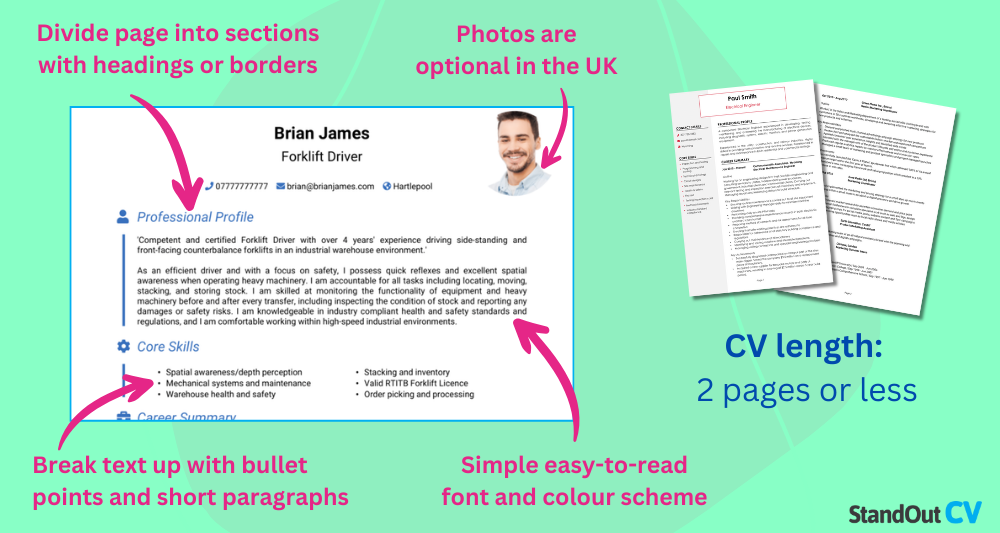

The way your CV format looks matters just as much as what it says – keeping it clean and structured makes it easier for employers to read. Recruiters need to look at countless applications, so they’re going to scan CVs quickly: make sure yours is easy to read and formatted professionally.
Follow these formatting tips to keep your CV readable:
- Bullet points – Break information into snappy, impactful points that are easy to skim through.
- Divide sections – Use clear section headings to organise your experience and qualifications.
- Use a clear and readable font – Focus on readability with a professional design and font choice.
- No more than 2 pages – This length ensures your highlights are front and centre while avoiding unnecessary fluff.
Carpenter CV profile
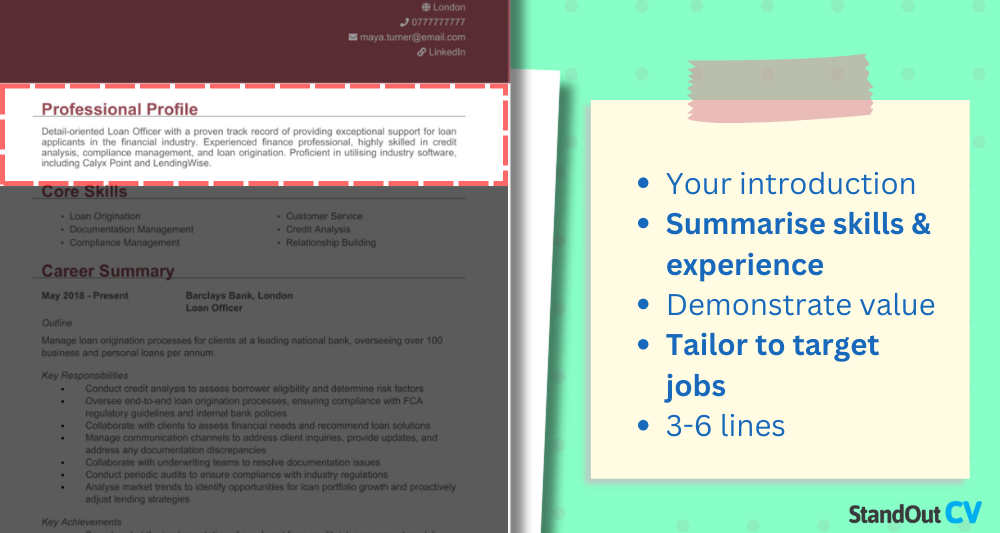
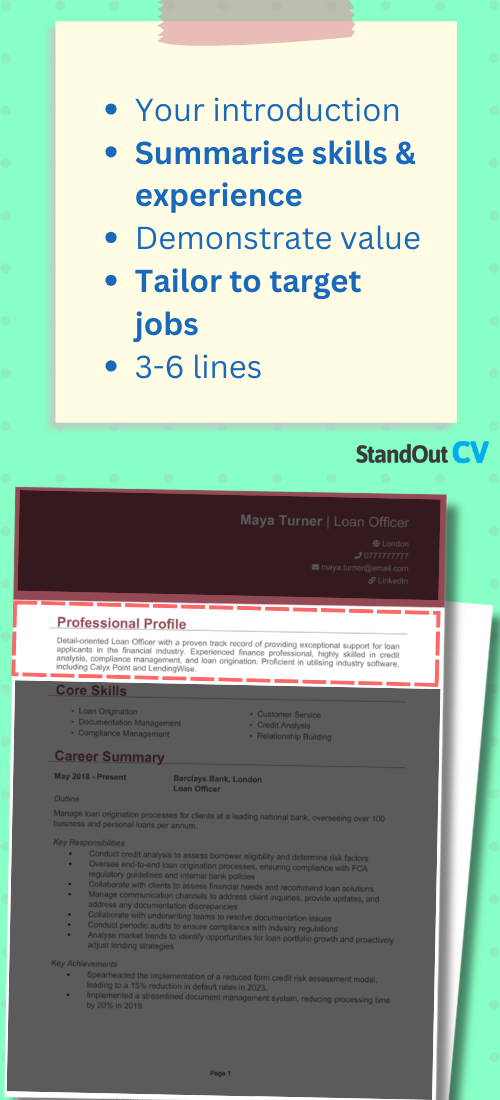
Your CV profile is an opportunity to introduce yourself as a skilled carpenter with relevant experience and expertise. It should be a brief yet impactful summary of your abilities and the value you bring to an employer. A strong introduction ensures your CV stands out from the start, giving employers a reason to keep reading.
Carpenter CV profile examples
Profile 1
Skilled Carpenter with four years of experience in residential and commercial construction, specialising in framing, cabinetry, and custom woodwork. Proficient in reading blueprints, measuring materials, and using power tools safely. Dedicated to delivering high-quality craftsmanship and ensuring structural integrity in all projects.
Profile 2
Experienced Carpenter with three years of expertise in joinery, furniture making, and interior installations. Adept at precision cutting, assembling wooden structures, and working with a variety of materials. Knowledgeable in using CNC machines, hand tools, and modern woodworking techniques. Committed to producing durable and aesthetically pleasing woodwork.
Profile 3
Versatile Carpenter with over six years of experience in structural and finish carpentry, specialising in renovations, flooring, and timber framing. Skilled in working with both traditional and modern techniques, including custom-built furniture and staircase installations. Passionate about delivering high-quality finishes and ensuring project specifications are met on time and within budget.
What to include in your Carpenter CV profile
Here’s what to include in your profile:
- Carpentry experience – Mention your years in the trade and areas of specialisation, such as construction, custom furniture, or restoration.
- Technical skills – Highlight proficiency in reading blueprints, using power tools, and working with different materials.
- Precision and attention to detail – Demonstrate your ability to create accurate and high-quality work.
- Safety and compliance knowledge – Show awareness of industry regulations and best practices.
- Project versatility – Whether you’ve worked on large-scale construction, home renovations, or custom woodworking, highlight your range of experience.
How to present your core skills section properly
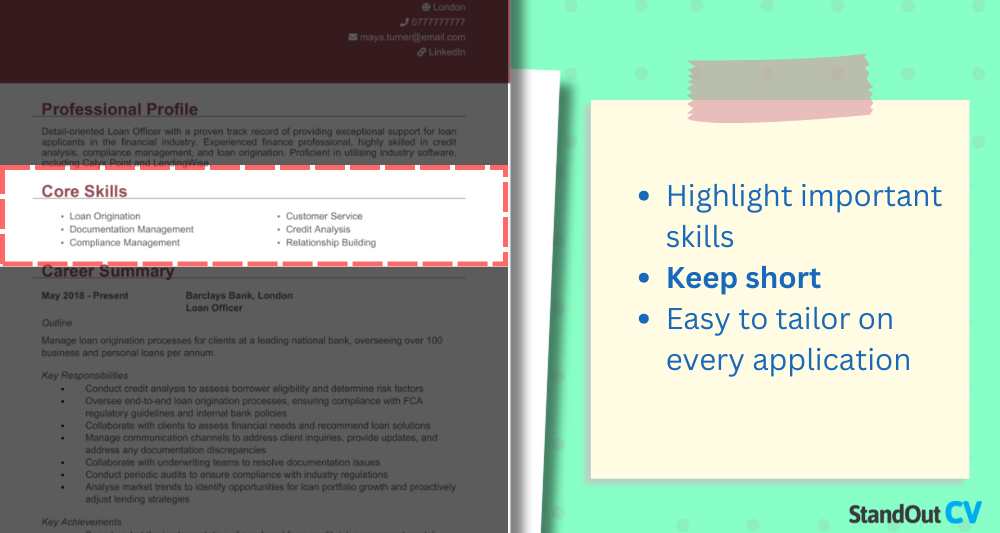

This section should highlight the most valuable skills you bring to the job, from precision woodworking to construction site experience. It should let recruiters see your key carpentry skills at a glance – focus on the technical abilities that make you a strong candidate
The best part? Skills for your CV are especially easy to tailor for different roles. If you specialise in a specific area, such as cabinetry, framework, or restoration, tailor your skills accordingly. If you’re applying for a role in general carpentry, ensure this section reflects a well-rounded skill set.
Key skills that make a Carpenter CV stand out
- Blueprint Reading and Interpretation – Understanding technical drawings, schematics, and construction plans to ensure accurate work.
- Woodworking and Joinery – Cutting, shaping, and assembling wood for furniture, frameworks, and structural components.
- Structural Framing – Constructing walls, floors, and roofs using timber and other materials in residential and commercial buildings.
- Cabinet and Furniture Making – Designing, crafting, and installing custom cabinets, tables, and other wood-based fixtures.
- Door and Window Installation – Fitting, repairing, and aligning doors, windows, and frames for functionality and aesthetics.
- Flooring Installation – Laying and finishing hardwood, laminate, or composite flooring to meet design specifications.
- Roofing and Decking Construction – Building and maintaining timber roofing structures, decks, and outdoor wood installations.
- Power Tool Operation – Using saws, drills, routers, and sanders safely and effectively for precision work.
- Wood Finishing and Staining – Applying varnish, paint, or protective coatings to enhance durability and appearance.
- Health and Safety Compliance – Adhering to workplace safety regulations, including PPE usage and hazard prevention.
Showcasing your work experience
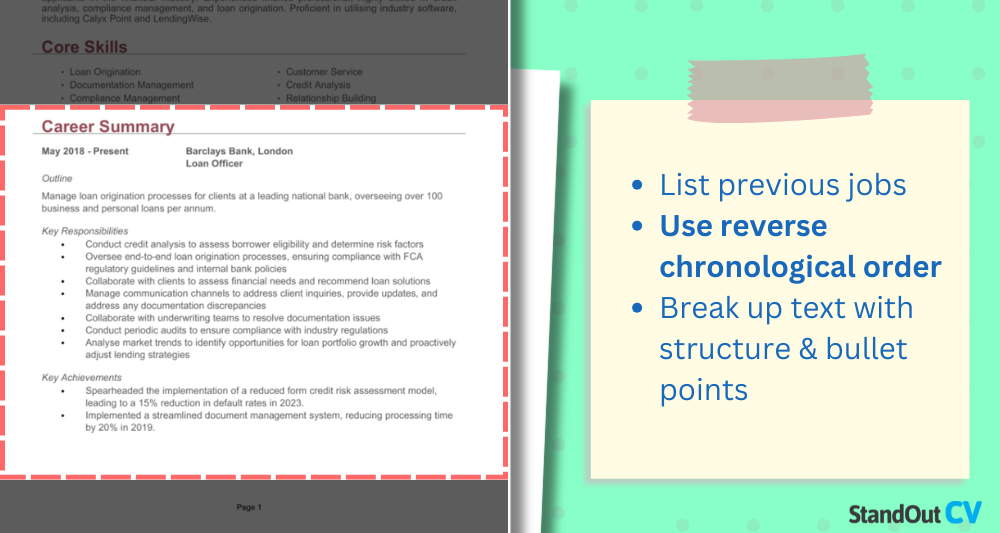
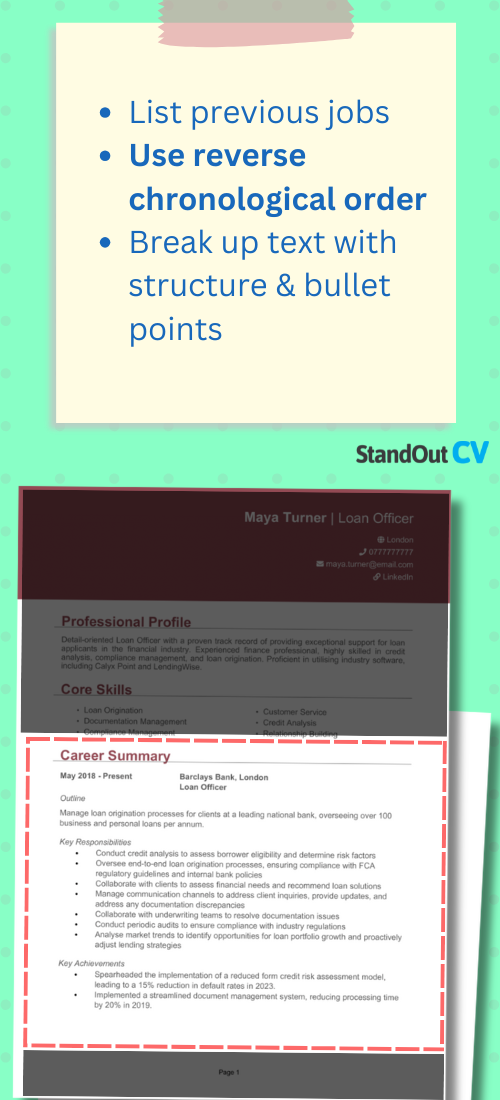
Carpentry is a hands-on trade, and hiring managers want to see how you’ve applied your skills in real-world projects. Your work experience section should highlight your problem-solving ability and your contributions to different projects.
If you’ve worked with specialist tools, materials, or construction methods, mention them in your experience section to strengthen your application. Start with your most recent job and work backward.
How to structure jobs
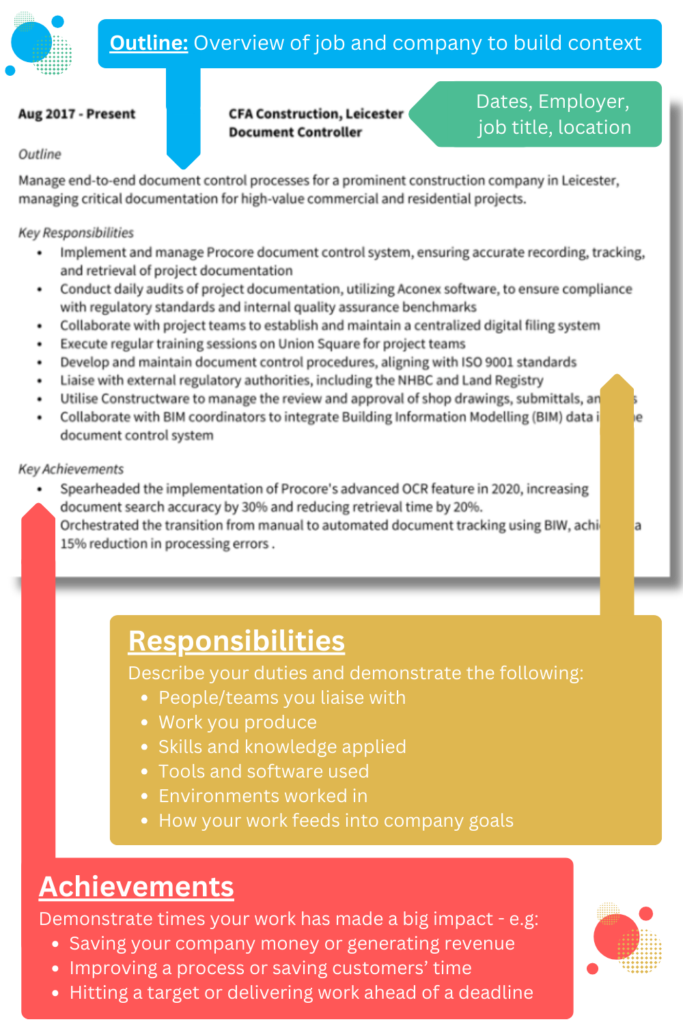
- Outline – Provide a brief description of the company or project you worked on and your role within the team.
- Responsibilities – Detail your key tasks, such as constructing frameworks, installing fittings, or custom woodworking. Use action words like “assembled,” “measured,” and “installed.”
- Achievements – Highlight any notable contributions, such as improving efficiency, completing projects ahead of schedule, or working on high-profile builds.
Example jobs for Carpenter
Carpenter | Good Work Wood Work
Outline
Constructed and installed wooden frameworks, cabinets, and furniture for a residential and commercial joinery firm, ensuring high-quality craftsmanship and structural integrity.
Responsibilities
- Read and interpreted blueprints to ensure accurate project execution.
- Cut, shaped, and assembled materials using hand and power tools.
- Installed doors, windows, flooring, and staircases with precision and durability.
- Maintained a clean and organised worksite, adhering to health and safety regulations.
- Worked closely with clients and designers to customise woodworking projects.
Achievements
- Completed a large-scale residential renovation project two weeks ahead of schedule.
- Reduced material waste by 20 percent through efficient cutting and planning.
- Received recognition for craftsmanship and attention to detail in high-end furniture making.
Joiner | Elite Interiors Ltd
Outline
Designed, built, and installed bespoke wooden fittings for high-end residential and commercial properties at a luxury interior design company, creating custom furniture and architectural woodwork.
Responsibilities
- Measured and cut wood and other materials to create custom doors, cabinets, and staircases.
- Worked with architects and designers to bring creative designs to life.
- Assembled and installed fitted kitchens, wardrobes, and shelving units.
- Used CNC machines and traditional hand tools to achieve precision craftsmanship.
- Ensured all joinery work complied with building codes and client specifications.
Achievements
- Increased workshop efficiency by 25 percent by streamlining production processes.
- Helped complete a luxury hotel refurbishment project, producing custom woodwork installations.
- Recognised for consistently delivering high-quality joinery work that exceeded client expectations.
Construction Carpenter | Pinnacle Builders
Outline
Worked on large-scale construction projects for a national building contractor, installing wooden frameworks and structural components to support major residential and commercial developments.
Responsibilities
- Erected timber frames, roofing structures, and formwork for concrete installations.
- Measured and cut wood for beams, joists, and partitions according to specifications.
- Worked with other tradespeople to ensure seamless integration of woodwork with plumbing and electrical installations.
- Maintained tools and equipment, ensuring all were in good working order.
- Followed strict health and safety procedures to prevent accidents on-site.
Achievements
- Contributed to the successful completion of a £2M housing development project.
- Reduced rework costs by improving measurement accuracy and precision cutting.
- Trained two apprentice carpenters, enhancing team productivity and skill development.
Education section
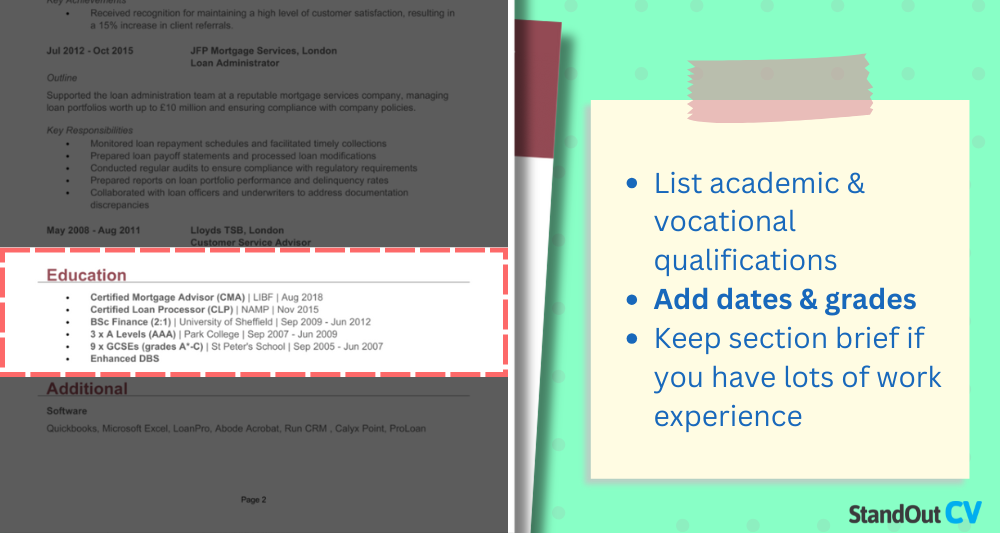

Carpentry is often learned through apprenticeships and trade qualifications. This section should concisely list your relevant education and certifications.
For those with extensive experience, this section can be brief. However, if you’re new to the trade, expand on coursework, hands-on training, and any additional qualifications that show your commitment to the profession.
Best qualifications for Carpenters
- NVQ Diploma in Carpentry and Joinery – A widely recognised qualification for skilled carpenters.
- City & Guilds Carpentry Certification – Demonstrates expertise in key carpentry skills and techniques.
- Apprenticeship in Carpentry and Joinery – Provides hands-on experience and industry training.
- CSCS Card (Construction Skills Certification Scheme) – Essential for working on construction sites in the UK.
- Health & Safety in Construction Certification – Shows awareness of site safety regulations and best practices.


